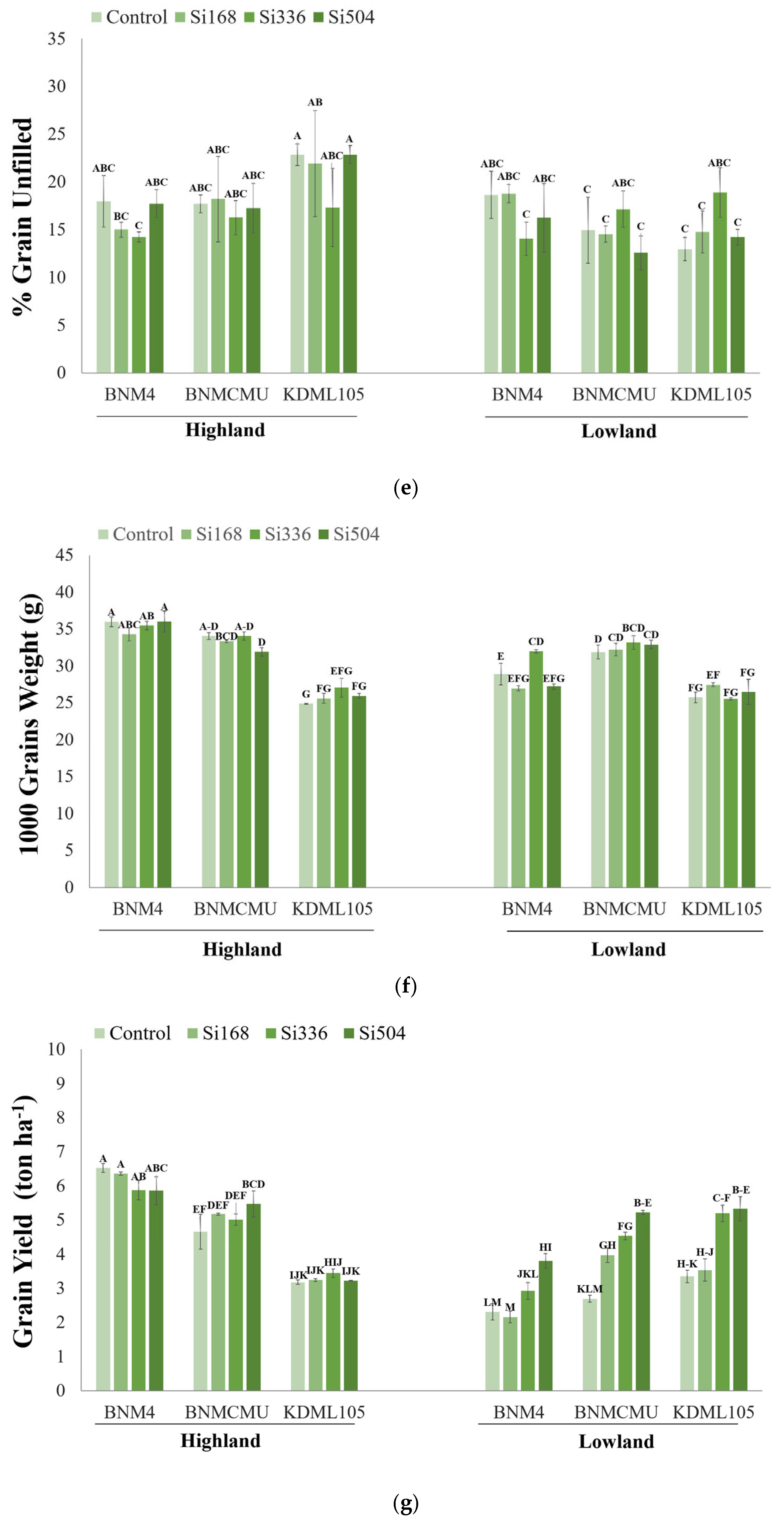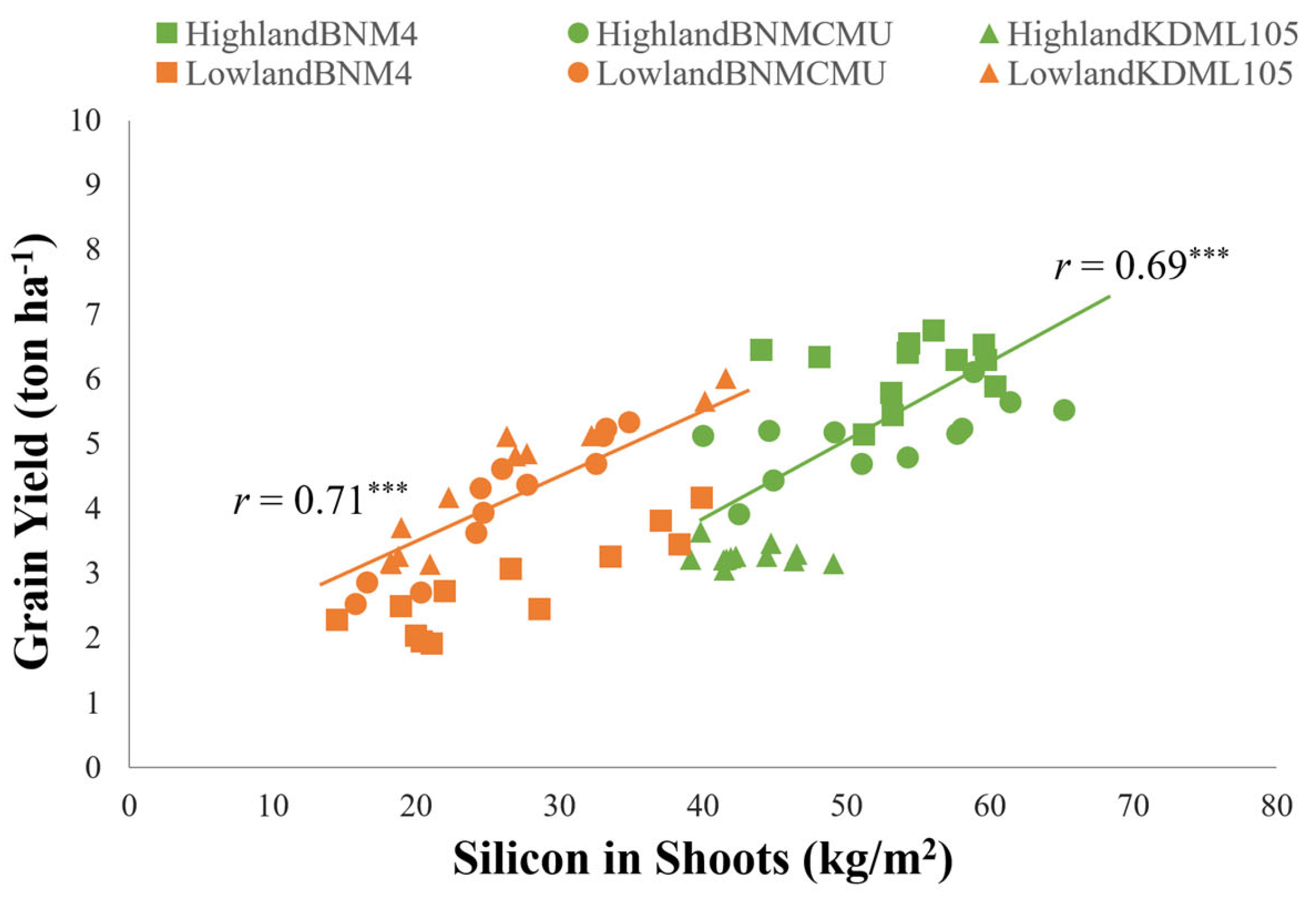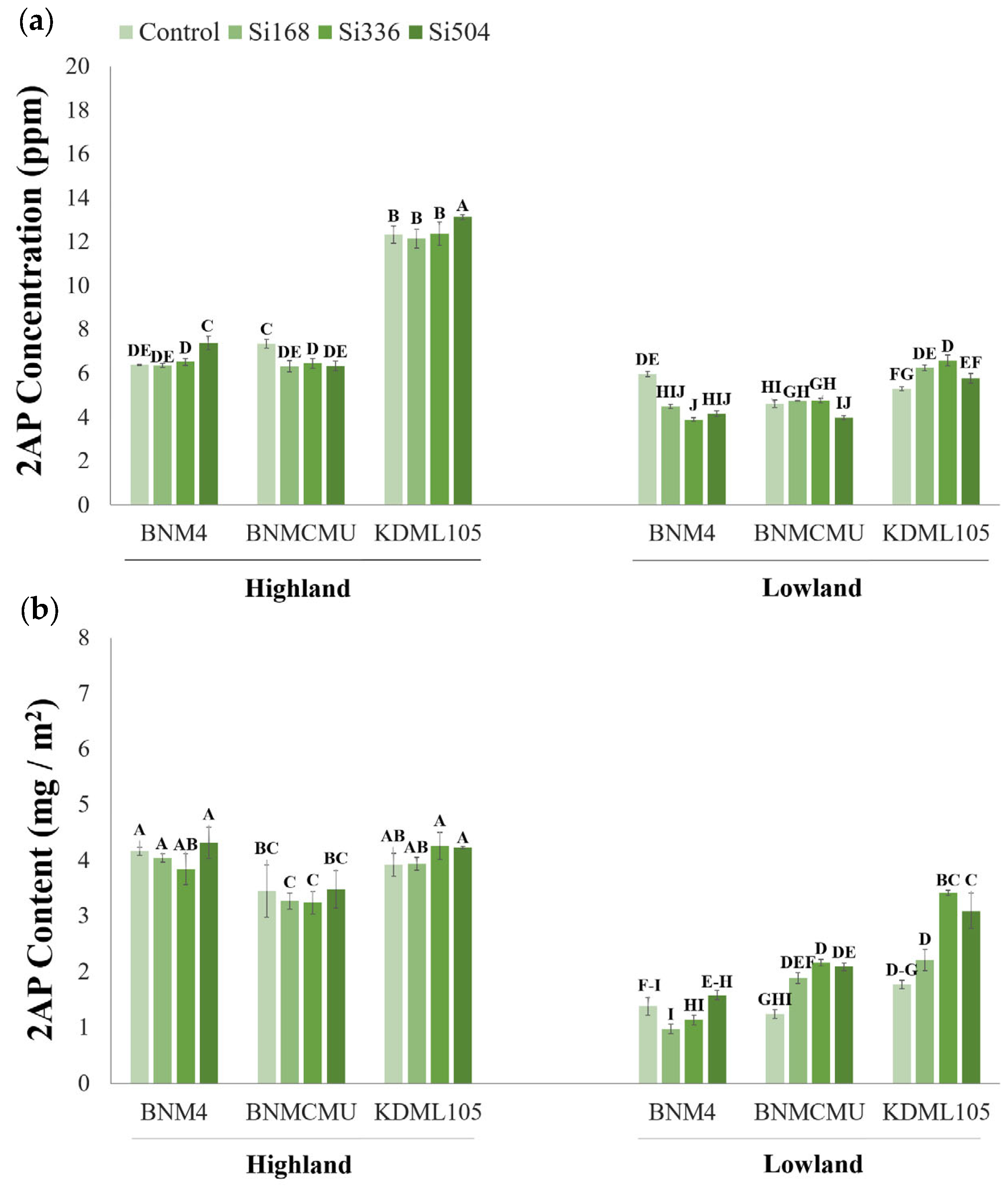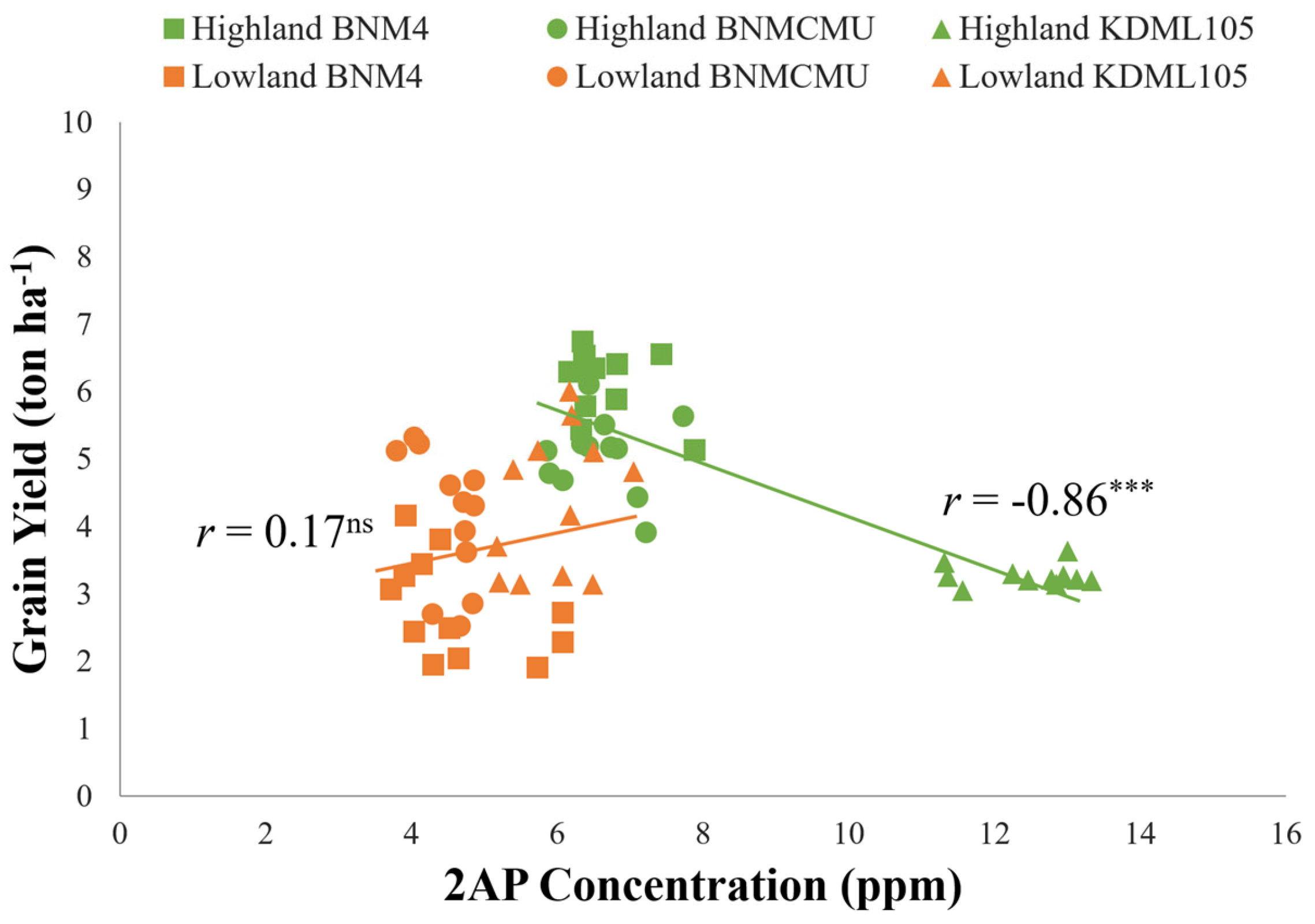Differential Responses of Thai Fragrant Rice to Silicon Application Enhance Yield and Aroma Under Highland and Lowland Ecosystems
Abstract
1. Introduction
2. Materials and Methods
2.1. Plant Materials and Silicon Treatment
2.2. Sampling and Data Collection
2.3. Silicon Concentration Analysis
2.4. 2-Acetyl-1-Pyrroline (2AP) Analysis
2.5. Sensory Evaluation
2.6. Statistical Analysis
3. Results
3.1. Effects of Location, Genotype, and Silicon Application on Agronomic Traits
3.2. Grain Yield and Yield Components
3.3. Silicon Accumulation in Plants
3.4. Grain Quality: 2-Acetyl-1-Pyrroline (2AP) Concentration and Content
3.5. Sensory Evaluation and Correlation Analyses
4. Discussion
5. Conclusions
Author Contributions
Funding
Data Availability Statement
Acknowledgments
Conflicts of Interest
References
- Yoshihashi, T.; Huong, N.T.T.; Inatomi, H. Precursors of 2-acetyl-1-pyrroline, a potent flavor compound of an aromatic rice variety. J. Agric. Food Chem. 2002, 50, 2001–2004. [Google Scholar] [CrossRef]
- Bradbury, L.M.; Fitzgerald, T.L.; Henry, R.J.; Jin, Q.; Waters, D.L. The gene for fragrance in rice. Plant Biotechnol. J. 2005, 3, 363–370. [Google Scholar] [CrossRef] [PubMed]
- Bryant, R.J.; McClung, A.M. Volatile profiles of aromatic and non-aromatic rice cultivars using SPME/GC–MS. Food Chem. 2011, 124, 501–513. [Google Scholar] [CrossRef]
- Mo, Z.; Li, W.; Pan, S.; Fitzgerald, T.L.; Xiao, F.; Tang, Y.; Wang, Y.; Duan, M.; Tian, H.; Tang, X. Shading during the grain filling period increases 2-acetyl-1-pyrroline content in fragrant rice. Rice 2015, 8, 9. [Google Scholar] [CrossRef]
- Jongdee, B.; Pantuwan, G.; Fukai, S.; Fischer, K. Improving drought tolerance in rainfed lowland rice: An example from Thailand. Agric. Water Manag. 2006, 80, 225–240. [Google Scholar] [CrossRef]
- Suwanmontri, P.; Kamoshita, A.; Fukai, S. Recent changes in rice production in rainfed lowland and irrigated ecosystems in Thailand. Plant Prod. Sci. 2021, 24, 15–28. [Google Scholar] [CrossRef]
- Kupkanchanakul, T. Bridging the Rice Yield Gap in Thailand. In Bridging the Rice Yield Gap in Asia and the Pacific; RAP Publication: Bangkok, Thailand, 2000; pp. 146–156. Available online: https://scholar.google.com/scholar?hl=th&as_sdt=0%2C5&q=BRIDGING+THE+RICE+YIELD+GAP+IN+THAILAND&btnG= (accessed on 15 January 2024).
- Itani, T.; Tamaki, M.; Hayata, Y.; Fushimi, T.; Hashizume, K. Variation of 2-acetyl-1-pyrroline concentration in aromatic rice grains collected in the same region in Japan and factors affecting its concentration. Plant Prod. Sci. 2004, 7, 178–183. [Google Scholar] [CrossRef]
- Goufo, P.; Duan, M.; Wongpornchai, S.; Tang, X. Some factors affecting the concentration of the aroma compound 2-acetyl-1-pyrroline in two fragrant rice cultivars grown in South China. Front. Agric. China 2010, 4, 1–9. [Google Scholar] [CrossRef]
- Goufo, P.; Wongpornchai, S.; Tang, X. Decrease in rice aroma after application of growth regulators. Agron. Sustain. Dev. 2011, 31, 349–359. [Google Scholar] [CrossRef]
- Imran, M.; Shafiq, S.; Ashraf, U.; Qi, J.; Mo, Z.; Tang, X. Biosynthesis of 2-Acetyl-1-pyrroline in fragrant rice: Recent insights into agro-management, environmental factors, and functional genomics. J. Agric. Food Chem. 2023, 71, 4201–4215. [Google Scholar] [CrossRef] [PubMed]
- Richmond, K.E.; Sussman, M. Got silicon? The non-essential beneficial plant nutrient. Curr. Opin. Plant Biol. 2003, 6, 268–272. [Google Scholar] [CrossRef]
- Ma, J.F.; Yamaji, N. Silicon uptake and accumulation in higher plants. Trends Plant Sci. 2006, 11, 392–397. [Google Scholar] [CrossRef] [PubMed]
- Guntzer, F.; Keller, C.; Meunier, J.D. Benefits of plant silicon for crops: A review. Agron. Sustain. Dev. 2012, 32, 201–213. [Google Scholar] [CrossRef]
- Zhu, Y.; Gong, H. Beneficial effects of silicon on salt and drought tolerance in plants. Agron. Sustain. Dev. 2014, 34, 455–472. [Google Scholar] [CrossRef]
- Ma, J.F.; Yamaji, N. A cooperative system of silicon transport in plants. Trends Plant Sci. 2015, 20, 435–442. [Google Scholar] [CrossRef]
- Hajipour, H.; Jabbarzadeh, Z. Effect of Foliar Application of Silicon on Physiological Responses of Chrysanthemum (Dendranthema × grandiflorum) at Two Different Growth Stages. J. Ornam. Plants 2016, 6, 39–47. Available online: https://scholar.google.com/scholar?hl=th&as_sdt=0,5&q=14.+Hajipour,+H.%3B+Jabbarzadeh,+Z.+Effect+of+Foliar+Application+of+Silicon+on+Physiological+Responses+of+Chrysanthemum+(Den-dranthema%C3%97+grandiflorum)+at+Two+Different+Growth+Stages.+Journal+of+Ornamental+Plants.+2016,+6,+39-47.+&btnG= (accessed on 15 January 2025).
- Liu, C.; Cui, B.; Huang, P.; Hu, C.; Zhao, J.; Li, Z.; Wang, J. Silicon Improves Soil Environment and Promotes Crop Growth under Compound Irrigation via Brackish Water and Reclaimed Water. Horticulturae 2024, 10, 317. [Google Scholar] [CrossRef]
- Wang, S.; Liu, P.; Chen, D.; Yin, L.; Li, H.; Deng, X. Silicon enhanced salt tolerance by improving the root water uptake and decreasing the ion toxicity in cucumber. Front. Plant Sci. 2015, 6, 759. [Google Scholar] [CrossRef]
- Ma, J.F.; Tamai, K.; Yamaji, N.; Mitani, N.; Konishi, S.; Katsuhara, M.; Ishiguro, M.; Murata, Y.; Yano, M. A silicon transporter in rice. Nature 2006, 440, 688–691. [Google Scholar] [CrossRef]
- Rao, G.B.; Susmitha, P.J.P.J. Silicon uptake, transportation and accumulation in Rice. J. Pharmacogn. Phytochem. 2017, 6, 290–293. Available online: https://scholar.google.com/scholar?hl=th&as_sdt=0%2C5&q=17.%09Rao%2C+G.+B.%3B+Susmitha%2C+P.+J.+P.+J.+Silicon+uptake%2C+transportation+and+accumulation+in+Rice.+J+Pharmacogn+Phytochem.+2017%2C+6%286%29%2C+290-293.+&btnG= (accessed on 15 January 2025).
- Ashfaq, W.; Fuentes, S.; Brodie, G.; Gupta, D. The role of silicon in regulating physiological and biochemical mechanisms of contrasting bread wheat cultivars under terminal drought and heat stress environments. Front. Plant Sci. 2022, 13, 955490. [Google Scholar] [CrossRef]
- Galindo, F.S.; Pagliari, P.H.; Rodrigues, W.L.; Fernandes, G.C.; Boleta, E.H.M.; Santini, J.M.K.; Jalal, A.; Buzetti, S.; Lavres, J.; Carvalho, M.; et al. Silicon amendment enhances agronomic efficiency of nitrogen fertilization in maize and wheat crops under tropical conditions. Plants 2021, 10, 1329. [Google Scholar] [CrossRef]
- Dai, W.M.; Zhang, K.Q.; Duan, B.W.; Sun, C.X.; Zheng, K.L.; Cai, R.; Zhuang, J.Y. Rapid determination of silicon content in rice (Oryza sativa). Chin. J. Rice Sci. 2005, 19, 460. Available online: http://www.ricesci.cn/EN/Y2005/V19/I5/460 (accessed on 15 January 2025).
- Boontakham, P.; Sookwong, P.; Jongkaewwattana, S.; Wangtueai, S.; Mahatheeranont, S. Comparison of grain yield and 2-acetyl-1-pyrroline (2AP) content in leaves and grain of two Thai fragrant rice cultivars cultivated at greenhouse and open-air conditions. Aust. J. Crop Sci. 2019, 13, 159–169. [Google Scholar] [CrossRef]
- Sood, B.C.; Siddiq, E.A. A Rapid Technique for Scent Determination in Rice. Indian J. Genet. Plant Breed 1978, 38, 268–275. [Google Scholar]
- Kovács, S.; Kutasy, E.; Csajbók, J. The multiple role of silicon nutrition in alleviating environmental stresses in sustainable crop production. Plants 2022, 11, 1223. [Google Scholar] [CrossRef]
- Sadras, V.O.; Richards, R.A. Improvement of crop yield in dry environments: Benchmarks, levels of organisation and the role of nitrogen. J. Exp. Bot. 2014, 65, 1981–1995. [Google Scholar] [CrossRef] [PubMed]
- Kim, Y.H.; Khan, A.L.; Shinwari, Z.K.; Kim, D.H.; Waqas, M.; Kamran, M.; Lee, I.J. Silicon treatment to rice (Oryza sativa L. cv. ‘Gopumbyeo’) plants during different growth periods and its effects on growth and grain yield. Pak. J. Bot. 2012, 44, 891–897. [Google Scholar]
- Cuong, T.X.; Ullah, H.; Datta, A.; Hanh, T.C. Effects of silicon-based fertilizer on growth, yield and nutrient uptake of rice in tropical zone of Vietnam. Rice Sci. 2017, 24, 283–290. [Google Scholar] [CrossRef]
- Chan-In, P.; Jamjod, S.; Prom-U.-Thai, C.; Rerkasem, B.; Russell, J.; Pusadee, T. Application of Silicon Influencing Grain Yield and Some Grain Quality Features in Thai Fragrant Rice. Plants 2024, 13, 1336. [Google Scholar] [CrossRef]
- Mitani, N.; Ma, J.F. Uptake system of silicon in different plant species. J. Exp. Bot. 2005, 56, 1255–1261. [Google Scholar] [CrossRef]
- Chaiwong, N.; Rerkasem, B.; Pusadee, T.; Prom-u-thai, C. Silicon application improves caryopsis development and yield in rice. J. Sci. Food Agric. 2021, 101, 220–228. [Google Scholar] [CrossRef] [PubMed]
- Yoshihashi, T.; Nguyen, T.T.H.; Kabaki, N. Area dependency of 2-acetyl-1-pyrroline content in an aromatic rice variety, Khao Dawk Mali 105. Jpn. Agric. Res. Q. JARQ 2004, 38, 105–109. [Google Scholar] [CrossRef]
- Tejakum, P.; Khumto, S.; Jamjod, S.; Yimyam, N.; Pusadee, T. Yield, grain quality and fragrance of a highland fragrant rice landrace variety, Bue Ner Moo. Khon Kaen Agric. J. 2019, 47, 317–326. [Google Scholar]
- Mo, Z.; Lei, S.; Ashraf, U.; Khan, I.; Li, Y.; Pan, S.; Duan, M.; Tian, H.; Tang, X. Silicon fertilization modulates 2-acetyl-1-pyrroline content, yield formation and grain quality of aromatic rice. J. Cereal Sci. 2017, 75, 17–24. [Google Scholar] [CrossRef]
- Du, B.; Wang, W.; Jiang, S.; Xie, Y.; Cheng, Y.; Xu, J.; Xing, D. Silicon and selenium fertilizer management improved productivity and aroma of fragrant rice. Crop Sci. 2021, 61, 936–946. [Google Scholar] [CrossRef]








| Locations | Genotypes | Si0 | Si168 | Si336 | Si504 |
|---|---|---|---|---|---|
| Highland | KDML105 | Moderately Strong aromatic | Strongly aromatic | Moderately Strong aromatic | Moderately Strong aromatic |
| BNM4 | Moderately Strong aromatic | Moderately aromatic | Non-Moderately aromatic | Moderately aromatic | |
| BNMCMU | Moderately aromatic | Moderately Strong aromatic | Moderately aromatic | Moderately aromatic | |
| Lowland | KDML105 | Strongly aromatic | Moderately Strong aromatic | Moderately Strong aromatic | Strongly aromatic |
| BNM4 | Non-aromatic | Moderately aromatic | Non-Moderately aromatic | Moderately aromatic | |
| BNMCMU | Non-Moderately aromatic | Moderately aromatic | Moderately aromatic | Moderately Strong aromatic |
Disclaimer/Publisher’s Note: The statements, opinions and data contained in all publications are solely those of the individual author(s) and contributor(s) and not of MDPI and/or the editor(s). MDPI and/or the editor(s) disclaim responsibility for any injury to people or property resulting from any ideas, methods, instructions or products referred to in the content. |
© 2025 by the authors. Licensee MDPI, Basel, Switzerland. This article is an open access article distributed under the terms and conditions of the Creative Commons Attribution (CC BY) license (https://creativecommons.org/licenses/by/4.0/).
Share and Cite
Wangkaew, B.; Rerkasem, B.; Prom-u-thai, C.; Toosang, S.; Pusadee, T. Differential Responses of Thai Fragrant Rice to Silicon Application Enhance Yield and Aroma Under Highland and Lowland Ecosystems. Agriculture 2025, 15, 2140. https://doi.org/10.3390/agriculture15202140
Wangkaew B, Rerkasem B, Prom-u-thai C, Toosang S, Pusadee T. Differential Responses of Thai Fragrant Rice to Silicon Application Enhance Yield and Aroma Under Highland and Lowland Ecosystems. Agriculture. 2025; 15(20):2140. https://doi.org/10.3390/agriculture15202140
Chicago/Turabian StyleWangkaew, Benjamaporn, Benjavan Rerkasem, Chanakan Prom-u-thai, Siriluk Toosang, and Tonapha Pusadee. 2025. "Differential Responses of Thai Fragrant Rice to Silicon Application Enhance Yield and Aroma Under Highland and Lowland Ecosystems" Agriculture 15, no. 20: 2140. https://doi.org/10.3390/agriculture15202140
APA StyleWangkaew, B., Rerkasem, B., Prom-u-thai, C., Toosang, S., & Pusadee, T. (2025). Differential Responses of Thai Fragrant Rice to Silicon Application Enhance Yield and Aroma Under Highland and Lowland Ecosystems. Agriculture, 15(20), 2140. https://doi.org/10.3390/agriculture15202140






